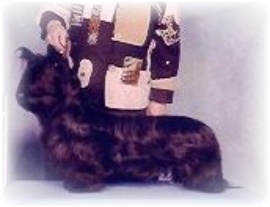|
|
 |
|

|
| Rob at 1 year winning a Sweepstakes in Canada with his breeder and co-owner, Laura Weber. |
Skye History...
The Skye
Terrier is different than most terrier breeds in appearance and temperament. The following is a brief description of the breed.
For complete information, please visit the Skye Terrier Club of America's website.
The Skye originated centuries ago on the Isle of Skye in Scotland. They were bred by farmers as workers whose
function was to hunt and destroy fox, badger and otter--the triple threat.
A Skye's acute scenting abilities and agile,
well muscled bodies enabled them to locate these vermin underground and tear them from their burrows. The Skye's short, sturdy
legs were well suited for digging, and the double coat served as protection from injury and bad weather.
Originally,
the drop eared variety was favored for this work, but later, in the nineteenth century, the prick eared variety became more
popular as a pet and show dog, partly as a result of Queen Victoria's fondness for the breed.
Physical
Characteristics...
The standard describes the ideal Skye as long in body with a level topline (back).
A typical Skye should stand about ten inches at the withers (shoulder) and should be twice his height in length. The coat
is a long, profuse, double-coat (the harsh textured overcoat covers a wooly undercoat) which is parted from the dog's nose
to his long, feathered tail. The head, held high on a gently crested neck, is long and strong, with a slight stop. It is moderately
wide at the back of the skull, tapering gradually to the muzzle, which is slightly full rather than snipey. The jaws are strong,
with the incisor teeth closing even or the the upper teeth slightly overlapping the lower. The dark eyes are closely set,
of medium size, and alight with life and intelligence. The eyes are veiled by the softer hair of the head.
The two
varieties of the breed, the drop ear and the prick ear, differ only in ear carriage. Both types of ears are well feathered.
Prick ears are of medium size, identical in carriage, set high on the skull, and erect at the outer edges. Drop ears are somewhat
larger and set lower. They lye flat against the skull and are identical, with no backward fold.
The legs of the forequarters
are strong, muscular and as straight as soundness and depth of chest will allow. The forearms curve slighly around the chest,
with the elbows close to the sides, neither loose nor tied. The shoulder blades are well laid back and are tightly placed
at the withers. Skyes have hare feet pointing forward, with thick pads and strong black nails. His hindquarters are strong,
full and well developed. The legs are short, muscular, moderately angulated and straight when viewed from behind. The tail,
thrown back in a moderate arc, without twist or curl, should not be raised above the topline except temporarily, when the
dog is excited. The breed's colors range from black to platinum, with all shades of gray in between, as well as cream and
fawn. All with dark hair on the muzzle, ears, and tail, preferably black.
Temperament...
The Skye Terrier has stamina, strength and courage. He is fearless, good tempered, loyal and sensitive. A Skye is
friendly and happy with those people he knows, but he is reserved and cautious with strangers. The Skye is not a breed for
everyone; his characteristic temperament must be understood. He is sensitive but not submissive and has a mind of his own.
The confidence, respect and love of a Skye must be deserved. He will please only those for whom he has high regard, and he
will be selective as to whom he will give his deep affection. The loyalty and devotion of a Skye, however, is unsurpassed
by any other breed. He is a delightful companion and alert protector of home and master.
|
 |
|
Please submit your inquiries to julie@elsmoor.com.
|
 |
|
|
|
|
|
 |

